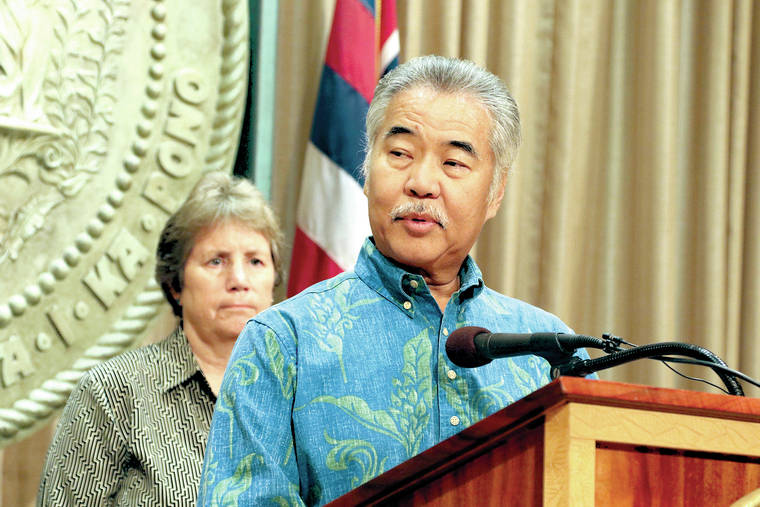HILO — Gov. David Ige announced Tuesday that the deadline for the Thirty Meter Telescope to begin construction has been pushed back two years and that he is rescinding the emergency proclamation he issued two weeks ago.
During a press conference in Honolulu, Suzanne Case, chairwoman of the state Board of Land and Natural Resources, said the University of Hawaii, at the request of the TMT leadership, asked the state DLNR on Tuesday morning to extend its conservation district use permit for the TMT site.
“We believe that they have made good faith efforts to go forward,” Case said. “Their efforts have been blocked by protesters on the mountain blocking the access road to their construction equipment.”
With the permit extended two years, the deadline for construction to begin is now Sept. 26, 2021.
Ige’s emergency proclamation, issued July 17, was made to provide more authority to law enforcement to close more areas and restrict access to the site. Ige said he was withdrawing it because there are no plans to move construction equipment to the TMT site in the near future because of the approach of hurricanes Erick and Flossie.
While there is now no obligation for the construction of the $1.4 billion observatory to begin before the new deadline, Ige said there have not been any “threats” by TMT to relocate to other locations should construction not begin soon.
“The two-year extension to the (permit) was requested out of an abundance of caution because the project has been challenged on so many things,” said Scott Ishikawa, TMT spokesperson. “We continue to support the ongoing conversations around those issues that are larger than TMT and Maunakea. At the same time, it is important for us to get started as soon as possible.”
Ishikawa said that between the appeals process with the state Supreme Court resolved in 2018 and the approximately six months it took TMT to obtain other necessary permits, the window during which TMT could begin construction was shorter than the two years established by the original deadline.
UH President David Lassner said in a statement Tuesday that the pressure of a deadline “has not been helpful in trying to resolve this extraordinarily complex situation.”
Lassner said he still believes in the educational and scientific benefits of the TMT project, but acknowledged “that TMT now represents a huge source of friction in our work to become a model indigenous-serving university and Hawaiian Place of Learning.”
“We need to keep the fabric of our university from being torn apart,” wrote Lassner. “In a time of differing opinions, points of view, historical understandings and lived experiences, we can learn from each other and ultimately strengthen our community.”
Protesters — who call themselves kiai, or protectors, of Maunakea, which they consider sacred — considered Ige’s announcement a victory, calling the extension of the deadline a “stall tactic” that proves the governor underestimated opposition to the project.
“Today we celebrate a victory that reaffirms our resolve,” read a statement from Puuhonua o Puu Huluhulu, the organized camp located at the base of the Maunakea Access Road. “Governor Ige has admitted that he underestimated our strength, unity and broad public support. Our numbers continue to grow and his ability to oppose his own people is increasingly becoming less and less justifiable. Ige’s rescinding of the emergency proclamation illustrates how he can no longer claim that we are threatening public safety. We are the public.”
Ige said he is considering issuing new emergency proclamations regarding the two hurricanes, depending on weather forecasts.
State law enforcement will remain at the Maunakea Access Road, which will remain closed.
Case said the continued presence of DLNR Division of Conservation and Resources Enforcement at the access road has impacted the division’s normal operations, but added that officers remain “committed” to their roles at the access road.
No discussions have taken place about initiating additional arrests at the access road, Ige said.
Ige’s announcements made no mention of the Maunakea Observatories workers, who have not been able to return to work at Maunakea summit save on a case-by-case basis whereby demonstrators allow limited access to technicians.
“For Maunakea Observatories, the governor’s statements left us uncertain,” said Rich Matsuda, chief of operations at W. M. Keck Observatory. “The situation remains unresolved … we’re caught in the middle with no way to get to work.”
Demonstrators have allowed technicians and engineers — but not astronomers — access to the summit for limited periods of time in exchange for a single protester vehicle allowed up each day, in a deal that was made Sunday evidently without the input of Hawaii County Mayor Harry Kim or the observatories, DLNR spokesman Dan Dennison wrote in an email.
However, the limited access is especially worrying given the impending storms, Matsuda said. Severe weather poses significant risks to the observatories, and while Matsuda said staff would be able to storm-proof the facilities under normal circumstances, the lack of access means it is unclear how many preparations can be completed before the storms arrive.
Matsuda said Keck staff would prioritize taking steps to protect instruments against power failure and loss of cooling, while also mitigating potential water and wind intrusion by reorienting the telescope dome away from the wind.
Earlier Tuesday, protest leader Kahookahi Kanuha said he and his fellow leaders are prepared to evacuate the puuhonua should the weather become too severe.
Email Michael Brestovansky at mbrestovansky@hawaiitribune-herald.com.

